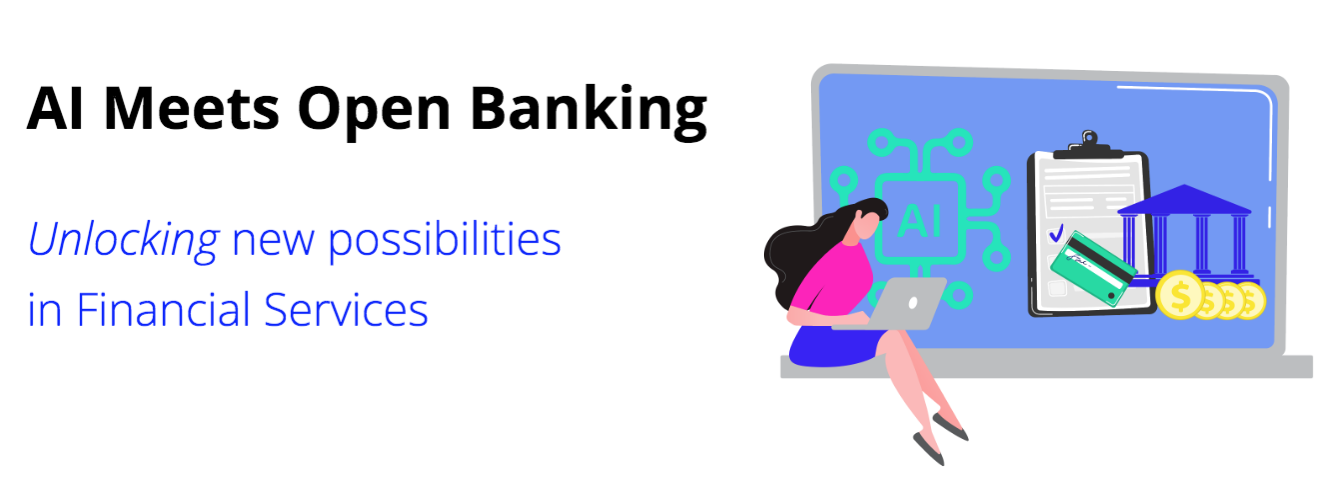
In a world increasingly shaped by technology, two of the most transformative forces in the financial services industry are Artificial Intelligence (AI) and Open Banking. These combined technologies are unlocking unprecedented possibilities, paving the way for a future where financial services are more intelligent, efficient, and tailored to each customer’s needs.
Personalized Services and Experiences: AI algorithms analyze vast amounts of data, allowing financial institutions to customize services to each customer’s needs. Combined with Open Banking, institutions can now access a broader range of data across various accounts and platforms. AI uses this data to provide personalized services. For instance, AI-powered virtual assistants, like JPMorgan’s COiN platform, provide real-time advice based on a comprehensive view of a customer’s financial data. The rise of voice assistant technologies foresees an integration of these technologies into banking services. This will enable customers to conduct banking transactions, get financial advice, and receive personalized banking insights through voice-activated AI platforms.
Enhanced Fraud Detection: The synergy between AI and Open Banking also bolsters financial security. AI’s capability to analyze large volumes of data enhances real-time fraud detection. Coupled with Open Banking, institutions can access data from various sources, creating a comprehensive view of each customer’s financial activities. This proactive approach enhances the mitigation of fraud attempts, as exemplified by Mastercard’s Decision Intelligence. Additionally, products like HSBC’s AI-powered anti-money laundering system, which uses advanced analytics to identify and flag suspicious transactions, are leading the way towards a safer banking environment. By 2026, it’s expected that AI will save the banking industry as much as $50 billion annually in fraud-related costs.
Revolutionizing Credit Assessment: AI’s capability to analyze comprehensive sets of data, combined with Open Banking, can also transform credit assessments. AI analyzes borrower data, such as income streams and transaction history, and determines the likelihood of default. This information allows lenders to tailor loan terms and interest rates, leading to more informed lending decisions. The interest rate will reflect not only the borrower’s credit score but also factors such as their income stability, spending habits, and financial history. Borrowers with stable financial situations may receive better rates despite having been penalized by traditional credit scoring. Soon, AI algorithms could replace traditional credit scores with real-time credit scoring. This process would dynamically update a borrower’s creditworthiness based on their most recent financial activities. As a borrower’s financial health improves, their credit score would reflect this immediately, allowing access to better loan terms faster than ever before.
Predictive Analytics and Advanced Financial Planning: AI and Open Banking also enable financial institutions to offer advanced financial planning. AI and Open Banking can be leveraged to provide personalized recommendations for investment strategies and retirement planning. Open banking APIs allow financial institutions to access external financial data sources, enhancing the accuracy of their predictive models. The future may see the rise of AI-driven dynamic budgeting tools. These tools could analyze and predict future expenses based on historical data, seasonal trends, and economic factors. For instance, a budgeting tool could predict a user’s utility bills based on their past consumption and anticipated weather patterns or foresee increased grocery expenses during holiday seasons. AI-powered platforms could offer personalized investment strategies based on a user’s financial goals, risk tolerance, and market trends. These platforms could dynamically adjust your portfolio in response to market changes and offer real-time alerts and recommendations when opportunities arise. They could also automatically rebalance portfolios to maintain an optimal risk-reward ratio. This empowers individuals to make more informed financial decisions, optimizing their investments, and achieving their long-term financial goals.
The Rise of AI-Driven Financial Ecosystems: Open Banking is set to create an interconnected financial ecosystem, transforming banking into a digital-first, customer-centric industry. According to PwC, it’s estimated that by 2026, Open Banking will provide a revenue opportunity of $9.8 billion. This evolution will empower customers to securely share their financial data, leading to enhanced product customization and improved financial management. By the end of this decade, we might witness the emergence of AI-driven financial ecosystems. Characterized by extensive collaborations between banks, fintech startups, technology giants, and other third-party service providers, these AI-powered platforms could generate over 60% of banking revenues by 2030, according to a recent McKinsey report. These ecosystems could not only offer banking and financial services but also an array of value-added services, such as insurance, wealth management, and e-commerce, creating a seamless, integrated financial experience.
Unlocking The True Potential of AI and Open Banking: By 2030, nearly 80% of traditional banking services could be replaced by AI-powered solutions, leading to a projected $1 trillion value shift, according to an Accenture report. Despite the exciting prospects, challenges remain. Ensuring privacy, security, and regulatory compliance is paramount. Advances in AI and machine learning techniques, like Federated Learning, can help strike a balance between personalized experiences and data privacy. Transparency in AI algorithms will be crucial in building trust with customers. We’re heading towards an era where AI and Open Banking will serve as the very foundation of the banking industry. As we stand at this crossroad, your thoughts, ideas, and feedback are invaluable. Let’s forge this path into the future of banking together. The future is now. Let’s embrace it together.
